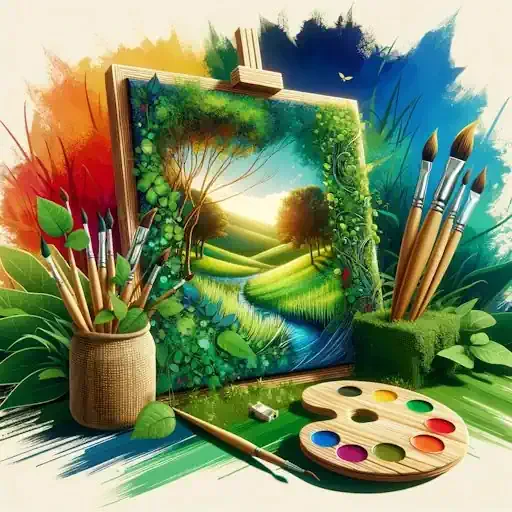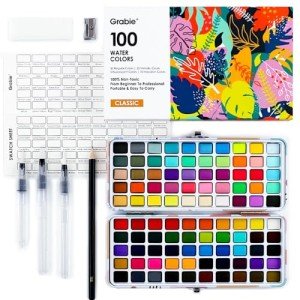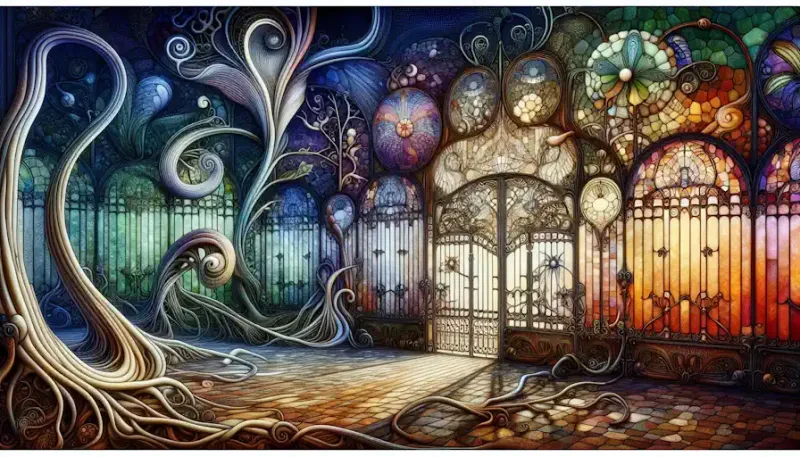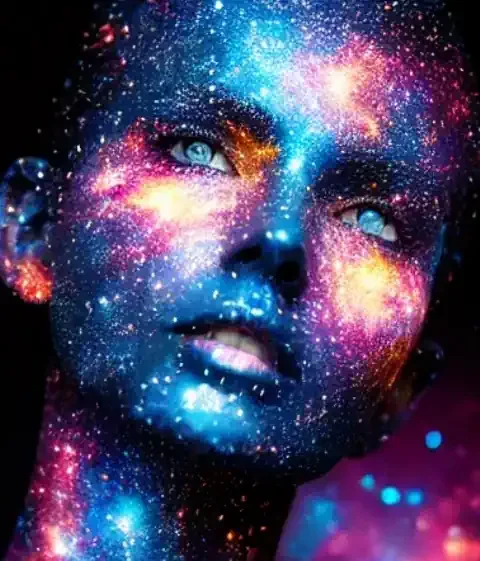Introduction: Embracing Eco-Friendly Art
Art has historically served as a mirror reflecting society's values, concerns, and aspirations. However, the dawn of the 21st century brings with it unprecedented environmental challenges, urging artists to reevaluate their practices and embrace sustainability. Eco-friendly art emerges as a response to this call, representing a paradigm shift in the way we conceive of creativity, innovation, and expression.
The urgency of environmental issues such as climate change, habitat destruction, and pollution has catalyzed a global movement towards sustainability in all facets of life, including the arts. Artists, educators, and cultural institutions are increasingly recognizing their role as stewards of the planet, harnessing the transformative power of art to inspire change, foster connection, and promote environmental justice.
At its core, eco-friendly art is about more than just using recycled materials or reducing waste—it's about reimagining the relationship between humanity and the natural world, recognizing our interconnectedness and interdependence. By embracing sustainability principles and holistic approaches, artists can not only create beautiful and thought-provoking artworks but also contribute to a more sustainable and equitable society.
Understanding Eco-Friendly Art: A Multifaceted Approach
Eco-friendly art encompasses a multifaceted approach to creativity that prioritizes environmental stewardship, social responsibility, and cultural preservation. At its essence, eco-friendly art is about fostering a deeper connection with the natural world and recognizing the intrinsic value of all living beings. It involves not only using sustainable materials and techniques but also considering the broader environmental and social impacts of artistic practice.
One of the key principles of eco-friendly art is the concept of "reduce, reuse, recycle," which encourages artists to minimize waste, conserve resources, and repurpose materials whenever possible. By adopting a circular mindset, artists can transform waste into raw materials, reimagine the lifecycle of their artworks, and minimize their ecological footprint.
Another important aspect of eco-friendly art is the promotion of environmental awareness and advocacy. Through their artwork, artists can raise awareness of pressing environmental issues, inspire action, and amplify marginalized voices. Whether through provocative installations, community-based projects, or participatory performances, eco-friendly artists use their creative platforms to spark dialogue, provoke reflection, and mobilize change.
Additionally, eco-friendly art often emphasizes collaboration, cooperation, and collective action. By partnering with environmental organizations, community groups, and other stakeholders, artists can leverage their creative talents to address complex environmental challenges and drive positive social change. Through collaborative projects, artists can harness the power of art to build bridges, forge connections, and foster resilience in the face of adversity.
In essence, eco-friendly art represents a holistic approach to creativity that transcends traditional boundaries and embraces the interconnectedness of all living beings. By weaving together threads of sustainability, social justice, and cultural diversity, eco-friendly artists are reshaping the art world and redefining what it means to be an artist in the 21st century.
Benefits of Eco-Friendly Art: Beyond Aesthetics
The benefits of eco-friendly art extend far beyond the realm of aesthetics, encompassing environmental, social, and personal dimensions. By embracing sustainability principles and holistic approaches, eco-friendly artists can create artworks that not only captivate the senses but also inspire positive change and foster connection with the natural world.
From an environmental perspective, eco-friendly art offers numerous benefits, including the conservation of natural resources, the reduction of pollution, and the mitigation of climate change. By using sustainable materials, minimizing waste, and reducing energy consumption, eco-friendly artists can minimize their ecological footprint and contribute to the preservation of ecosystems worldwide.
Socially, eco-friendly art has the power to bring people together, foster dialogue, and promote cultural exchange. Through community-based projects, public installations, and participatory performances, eco-friendly artists can engage diverse audiences in conversations about pressing social and environmental issues. By creating spaces for reflection, connection, and collaboration, eco-friendly art can inspire individuals and communities to work together towards a more sustainable and just society.
On a personal level, engaging in eco-friendly art can be deeply rewarding and fulfilling. Many artists find that working with sustainable materials and techniques enhances their creativity, deepens their connection to nature, and fosters a sense of purpose and meaning in their artistic practice. By aligning their creative pursuits with their values and beliefs, artists can find fulfillment and satisfaction in knowing that their artwork contributes to positive social and environmental outcomes.
Ultimately, the benefits of eco-friendly art are manifold, encompassing environmental, social, and personal dimensions. By embracing sustainability principles and holistic approaches, artists can create artworks that not only inspire and delight but also contribute to a more sustainable and equitable world for future generations.
Eco-Friendly Art Techniques: Innovation and Creativity
Eco-friendly art techniques encompass a wide range of innovative approaches to creativity that prioritize sustainability, resourcefulness, and innovation. From traditional methods passed down through generations to cutting-edge technologies and materials, eco-friendly artists draw inspiration from diverse sources to create artworks that are both aesthetically compelling and environmentally responsible.
One of the key principles of eco-friendly art techniques is the concept of "working with what you have." Rather than relying on expensive or environmentally harmful materials, eco-friendly artists seek out sustainable alternatives that are readily available, affordable, and accessible. This may involve using recycled or upcycled materials, repurposing found objects, or sourcing materials locally to minimize transportation emissions.
Another important aspect of eco-friendly art techniques is the emphasis on craftsmanship, skill, and attention to detail. By honing their craft and mastering traditional techniques, eco-friendly artists can create artworks of exceptional quality and beauty that stand the test of time. Whether working with natural pigments, handmade paper, or traditional printmaking methods, eco-friendly artists take pride in their workmanship and celebrate the unique characteristics of each material and technique.
Additionally, eco-friendly art techniques often involve experimentation, exploration, and innovation. By pushing the boundaries of traditional art-making practices and embracing new technologies, materials, and processes, eco-friendly artists can create artworks that are fresh, dynamic, and engaging. Whether experimenting with digital art, biofabrication, or kinetic sculpture, eco-friendly artists are at the forefront of creative innovation, pushing the boundaries of what is possible in the world of art.
In essence, eco-friendly art techniques represent a fusion of tradition and innovation, craftsmanship and creativity. By embracing sustainability principles and holistic approaches, artists can create artworks that not only captivate the senses but also inspire positive change and foster connection with the natural world.
Sustainable Art Supplies: Choosing Wisely
Choosing sustainable art supplies is essential for eco-friendly artists seeking to minimize their environmental impact and promote a more sustainable art industry. From paints and brushes to canvas and paper, every material used in art-making has implications for the planet, and it's important to make informed choices that align with sustainability principles.
Recycled and upcycled materials offer a sustainable alternative to conventional art supplies, reducing the need for virgin resources and diverting waste from landfills. Recycled paper, for example, is made from post-consumer waste such as newspapers, magazines, and cardboard, and is available in a variety of textures and weights for drawing, painting, and printmaking. By choosing recycled paper, artists can support the circular economy and reduce their carbon footprint while creating beautiful and impactful artworks.
Non-toxic paints and pigments are another essential component of eco-friendly art supplies, offering artists vibrant colors without harmful chemicals or heavy metals. Traditional oil and acrylic paints often contain volatile organic compounds (VOCs) and other toxic ingredients that can pose risks to human health and the environment. By opting for water-based paints, natural pigments, and plant-based dyes, artists can create safer and more sustainable artworks while minimizing their exposure to harmful substances.
Eco-friendly brushes and tools are crafted from sustainable materials such as bamboo, recycled plastic, and natural fibers, offering artists a renewable alternative to conventional brushes made from animal hair or synthetic bristles. Bamboo, in particular, is prized for its fast growth rate, low environmental impact, and versatility, making it an ideal choice for eco-conscious artists seeking durable and sustainable tools for their creative practice.
Choosing sustainably sourced and ethically produced art supplies is essential for eco-friendly artists seeking to align their creative practice with their values. By supporting companies that prioritize environmental stewardship, social responsibility, and transparency in their supply chains, artists can contribute to a more sustainable and equitable art industry while creating beautiful and meaningful artworks.
DIY Eco-Friendly Art Supplies: Creativity Unleashed
For artists seeking a more hands-on approach to sustainability, DIY eco-friendly art supplies offer a creative and resourceful solution. By repurposing household items, natural materials, and everyday objects, artists can create custom-made supplies tailored to their specific needs while minimizing waste and reducing their environmental footprint.
Natural pigments and dyes can be made from a wide range of plant-based materials, including fruits, vegetables, flowers, and spices. By extracting color from natural sources such as turmeric, beetroot, indigo, and saffron, artists can create vibrant and unique pigments for painting, dyeing, and printmaking. Experimenting with different extraction methods, mordants, and modifiers allows artists to achieve a diverse range of colors and effects while embracing the beauty and variability of natural materials.
Homemade paper offers artists a sustainable alternative to commercially produced paper, allowing them to create custom-made sheets with unique textures, colors, and finishes. By recycling old paper, fabric scraps, and plant fibers, artists can produce handmade paper that is both environmentally friendly and visually striking. Techniques such as papermaking, pulp painting, and embossing provide endless opportunities for experimentation and creativity, enabling artists to express themselves through the medium of paper in innovative and meaningful ways.
DIY paintbrushes and tools can be crafted from a variety of natural and recycled materials, including bamboo skewers, twigs, feathers, and bottle caps. By repurposing everyday objects and household items, artists can create custom-made brushes and tools that suit their artistic style and preferences while reducing waste and promoting sustainability. Experimenting with different shapes, sizes, and textures allows artists to discover new techniques and approaches to mark-making, adding depth and dimension to their artworks.
By embracing DIY eco-friendly art supplies, artists can reclaim agency over their creative process and explore new avenues of self-expression while minimizing their environmental impact. Whether experimenting with natural pigments, handmade paper, or homemade brushes, artists can unleash their creativity and ingenuity to create artworks that are both beautiful and sustainable.
Case Studies of Eco-Friendly Artists: Inspiring Change
Numerous artists around the world are leading by example, demonstrating the transformative power of eco-friendly art to inspire change and catalyze positive action. Through their innovative approaches, creative ingenuity, and unwavering commitment to sustainability, these artists are reshaping the art world and redefining what it means to be an artist in the 21st century.
One such artist is Marina DeBris, whose striking sculptures made from beach debris have garnered international acclaim for their powerful message about plastic pollution and ocean conservation. By collecting and repurposing discarded plastic items found on beaches around the world, DeBris creates thought-provoking artworks that challenge viewers to confront the environmental consequences of their everyday actions. Through her work, she highlights the interconnectedness of human activity and marine ecosystems, inspiring individuals and communities to take action to protect our oceans and shorelines.
Another artist making waves in the world of eco-friendly art is Aurora Robson, whose intricate sculptures crafted from salvaged plastic waste offer a poignant commentary on consumerism, waste, and environmental degradation. By transforming plastic bottles, packaging materials, and other discarded items into ethereal works of art, Robson invites viewers to reconsider their relationship with plastic and imagine new possibilities for recycling and reuse. Through her innovative use of materials and her dedication to sustainability, she challenges conventional notions of beauty and value while raising awareness of the urgent need to address the global plastic crisis.
These are just two examples of the countless artists who are harnessing the power of art to promote environmental awareness, inspire action, and drive positive change. Whether through sculpture, painting, photography, or performance, eco-friendly artists are using their creative talents to address pressing issues such as climate change, biodiversity loss, and social justice. Through their work, they remind us of the profound impact that art can have on hearts, minds, and communities, and inspire us to imagine a more sustainable and equitable future for all.
Challenges and Solutions: Navigating the Path to Sustainability
Despite the many benefits of eco-friendly art, artists face a range of challenges when transitioning to sustainable practices and materials. These challenges may include limited access to eco-friendly supplies, higher costs compared to conventional materials, and resistance from traditionalists who are hesitant to embrace change. However, there are numerous solutions and strategies available to overcome these obstacles and support artists on their journey towards sustainability.
One solution is to foster collaboration and knowledge-sharing within the artistic community, allowing artists to learn from one another, exchange ideas, and pool resources. By joining forces with like-minded individuals and organizations, artists can leverage collective expertise and support to navigate the complexities of sustainability and overcome common challenges. Whether through workshops, forums, or online networks, community-based initiatives offer valuable opportunities for artists to connect, collaborate, and inspire one another to embrace eco-friendly practices.
Advocacy and activism are also powerful tools for promoting sustainability in the arts and driving systemic change within the industry. By advocating for policy reforms, industry standards, and consumer education initiatives, artists can help create an enabling environment that supports and incentivizes sustainable practices. Whether lobbying for government funding for eco-friendly art projects, calling for stricter regulations on toxic chemicals, or raising awareness of sustainable alternatives, artists can use their voices and platforms to effect positive change at local, national, and global levels.
Financial incentives and support mechanisms can help alleviate some of the financial barriers to adopting eco-friendly practices and materials. Grants, scholarships, and funding opportunities specifically earmarked for sustainable art projects can provide artists with the financial resources they need to invest in eco-friendly supplies, equipment, and infrastructure. Similarly, subsidies, tax breaks, and other financial incentives can encourage manufacturers and retailers to develop and market eco-friendly art supplies at competitive prices, making them more accessible and affordable to artists of all backgrounds.
Education and outreach play a crucial role in fostering a culture of sustainability within the artistic community and beyond. By integrating sustainability principles into art education curricula, workshops, and training programs, educators can equip artists with the knowledge, skills, and tools they need to create art that is both aesthetically compelling and environmentally responsible. Additionally, public awareness campaigns, exhibitions, and events can help raise awareness of the environmental and social impacts of art-making practices, inspiring individuals and communities to embrace eco-friendly art and support sustainable artists.
By addressing these challenges and embracing innovative solutions, artists can overcome barriers to sustainability and unlock new opportunities for creativity, collaboration, and impact. Through collective action and shared commitment, artists can lead the way towards a more sustainable and resilient art world that celebrates diversity, fosters connection, and promotes harmony with the planet.
The Future of Eco-Friendly Art: Envisioning Possibilities
As awareness of environmental issues continues to grow and evolve, the future of eco-friendly art looks increasingly promising. Artists, educators, policymakers, and activists are coming together to imagine new possibilities for sustainability in the arts and to chart a course towards a more sustainable and equitable future.
One emerging trend is the integration of technology and sustainability in art-making practices, enabling artists to create innovative and interactive artworks that engage audiences in new and unexpected ways. From augmented reality installations to immersive experiences powered by renewable energy, technology offers exciting opportunities for artists to push the boundaries of creativity while promoting environmental awareness and social change.
Another trend is the rise of community-based and participatory art projects that empower individuals and communities to co-create artworks that reflect their values, experiences, and aspirations. By engaging diverse voices and perspectives in the artistic process, these projects foster collaboration, dialogue, and collective action, generating meaningful connections and fostering a sense of belonging and ownership among participants.
The circular economy is also gaining traction as a model for sustainability in the arts, encouraging artists to rethink the lifecycle of their artworks and embrace principles of reduce, reuse, and recycle. By designing artworks with longevity, durability, and reparability in mind, artists can minimize waste and maximize the value of materials, resources, and energy invested in their creation. Additionally, by incorporating recycled and upcycled materials into their artworks, artists can close the loop on resource consumption and contribute to the circular economy.
Collaboration and cross-disciplinary partnerships are essential for advancing sustainability in the arts and fostering innovation and resilience in the face of complex challenges. By bringing together artists, scientists, engineers, designers, policymakers, and community members, collaborative projects can leverage diverse perspectives and expertise to develop creative solutions to pressing environmental and social issues. Whether exploring alternative materials, developing sustainable technologies, or engaging communities in collective action, cross-disciplinary collaborations offer new pathways for sustainable art and cultural expression.
Ultimately, the future of eco-friendly art depends on our collective willingness to embrace change, challenge conventions, and reimagine the role of art in society. By fostering creativity, collaboration, and compassion, artists can inspire meaningful dialogue, catalyze positive action, and shape a more sustainable and equitable world for generations to come.
Conclusion: Towards a Sustainable Artistic Renaissance
In conclusion, eco-friendly art offers a transformative vision for the future of creativity and expression, one that celebrates diversity, fosters connection, and promotes harmony with the planet. By embracing sustainability principles and holistic approaches, artists can redefine the boundaries of art-making and contribute to a more sustainable and equitable society.
As we navigate the complex challenges of the 21st century, let us draw inspiration from the natural world and harness the power of art to envision and create a brighter future for all. Through creativity, collaboration, and collective action, we can embark on a sustainable artistic renaissance that celebrates the beauty and resilience of life on Earth and inspires us to imagine new possibilities for a more just, regenerative, and thriving world.
Together, let us weave a tapestry of creativity, compassion, and stewardship that honors the interconnectedness of all living beings and cultivates a culture of care and reverence for the Earth. By embracing eco-friendly art, we can unleash the transformative power of creativity to inspire change, elevate consciousness, and shape a more sustainable and beautiful world for generations to come.







